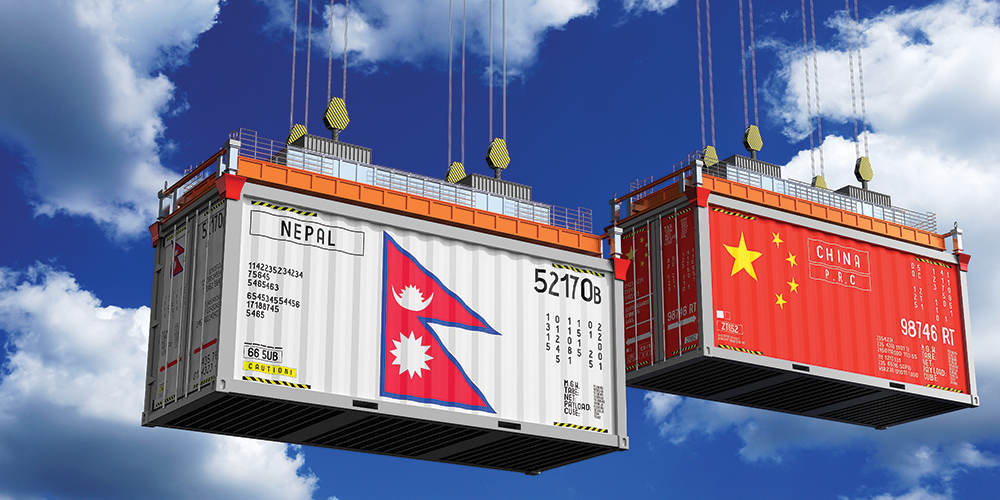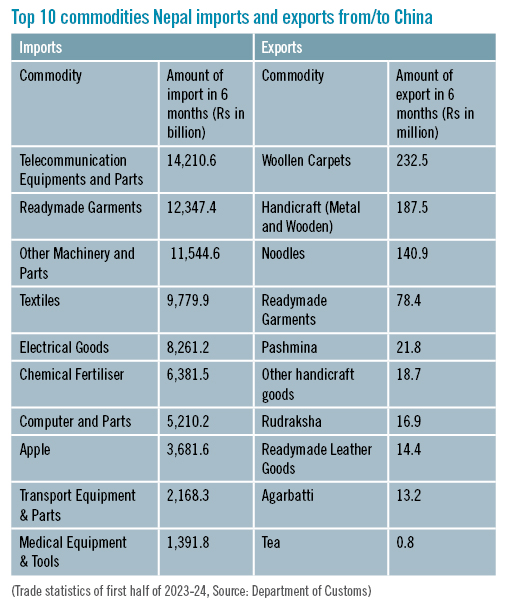
Nepal has a long history of trade with China, especially with Tibet via mountain passes. The story of importing salt from Tibet and exporting rice there carries the history of bilateral trade relations between the two neighbours. Nevertheless, China is the second largest trading partner of Nepal in the current context. China’s dominating presence in the world market with export goods led the country to be the world’s second largest economy and global manufacturing hub. The global supply chain without China is unimaginable. However, whether Nepal has benefited from bilateral trade with China despite being an immediate neighbour and the long-standing trade and economic relations is a pressing issue.
While citing the data of Nepal-China trade in the first half of this Fiscal Year 2023-24, Nepal has imported goods worth Rs 147.39 billion, whereas exports to China stand at a dismal Rs 1.60 billion; a huge imbalance. Nepal’s export to China is only 1.08% of its imports from China.
According to Nepal Trade Portal, China provides zero-tariff treatment to about 8,000 goods originating in Nepal that are exported to China. “These goods make up nearly 95% of the total exports of Nepal to China,” says the portal hosted by Trade and Export Promotion Centre under the Ministry of Industry, Commerce and Supplies on behalf of all government agencies. However, Nepal has not been able to utilise the facility for a large number of products granted under the duty-free quota-free (DFQF) market access.
The trade deficit of Nepal with China has been on an increasing trend as Nepal has not been able to boost exports to the northern neighbour by enhancing the country’s production capacity. Rising import of consumable goods has posed a threat of not only being a consumer market of Chinese manufacturers but also losing our production base. “The intermediate goods we import from China and the rest of other trading partners supports in boosting production in the country or in value addition of the services,” sa Laxman Bahadur Basnet, Former Executive Director of Nepal Intermodal Transport Development Board (NITDB). “In the context of Nepal-China trade, the portion of commodities in the import basket of intermediate goods is around 50%,” he added.
Although China has granted zero tariff entry facility to over 8,000 Nepali products since 2009, Nepal has not been able to bring the trade deficit down by capitalising on the facility. Nepal’s alarming trade deficit with China is a matter of concern and the Ministry of Industry, Commerce and Supplies has been in frequent correspondence with its Chinese counterpart to provide market access to a few goods that have competitive and comparative advantage. The list includes 495 products, stating that Nepal has not been able to use the DFQF facilities granted by China. “The DFQF facility is offered on products such as parts of ship which Nepal has no expertise to develop,” said Purushottam Ojha, Former Secretary of the Ministry of Industry Commerce and Supplies, adding, “Agro and forest products including medicinal herbs which Nepal has strength to export in the Chinese market could not meet sanitary and phytosanitary criteria.”

Non-tariff barriers in trade with China
Nepal is an agrarian country, and it has comparative and competitive strength in non-timber forest products (NTFP) as well, however, due to the non-tariff barriers of Chinese quarantine such products have not been able to enter the Chinese market. Citing an example of Nepal’s citrus fruit export agreement with China, the requirement of pest-free area product impaired Nepal’s export potential to China.
“The consignment must comply with the protocol of phytosanitary requirements for the export of citrus fruits from Nepal to China and it must be free of any quarantine pest concern to China. That requires a quarantine certificate indicating producing area, the orchard and the packing house,” according to MoICS.
Nepal’s lack of competitiveness coupled with non-tariff barriers has hit Nepal’s export potential hard. On the other hand, to protect human, animal and environmental health, countries like China have developed stringent tariff barriers, mutual recognition agreement (MRA) to harmonise Nepal’s lab with Chinese standards is critical, say trade experts.
Deadly proposal of Free Trade Agreement
Despite the numerous agreements in the past to boost trade relations with China, Nepal’s trade deficit with China is widening. In the meantime, China has proposed a free trade agreement (FTA) with Nepal, presenting an economic analysis which says it will benefit Nepal’s GDP with 4.8% expansion.
However, the feasibility study of the proposed FTA with China conducted by the MoICS has drawn a conclusion that the FTA could bring a decline of 0.24% in Nepal’s economy, unless Nepal is able to bring Foreign Direct Investment (FDI) from China to enhance production and competitiveness along with robust connectivity that lowers the logistics cost of trade. Otherwise, the move of providing tariff concession to Chinese goods under FTA will not only hurt the government’s revenue, it could destroy the country’s already weakened production base due to free flow of cheaper goods from the northern neighbour.
Nepal is further preparing to sign BIA (Bilateral Investment Agreement) with China instead of FTA. “Investment in the production sector and infrastructure is our priority and if we can bring investment from China in those sectors it will help to improve our competitiveness along with addressing supply-side constraints and boost exports,” a highly placed source at MoICS told Business 360.

Nepal and China have already signed a few agreements to strengthen economic ties between the two nations. However, the effectiveness of these agreements is often questioned. Trade and Payments Agreement; Agreement on Management of Ports in Nepal China Border Areas; Transit Transport Agreement, Trade and Other Related Matters Agreement; Letter of Exchange on Zero-tariff are a few agreements signed with China. Apart from this, Nepal-China’s Tibet Trade Facilitation Committee (NTTFC) is the bilateral mechanism to hold discussions on trade related affairs.
Most of the country’s trade with China takes place via sea, though trade via land route was also picking up before China’s unilateral decision to close the land route during the earthquake and later during the Covid 19 pandemic. China’s unilateral decision of opening and closing down ports for indefinite periods bleeds traders white.
In March 2016, Nepal and China signed the Transit and Transport Agreement. Two years after the agreement, signing the agreement implementation protocol China allows Nepal to use Chinese ports namely, Tianjin, Shenzhen, Lianyungang, and Zhanjiang, apart from three land ports in Lanzhou, Lhasa and Shigatse for trade with third countries. However, third-country trade via China is yet to take place as traders say it is not economically feasible to trade with third countries through China. Further, modalities and procedures are not clear for bringing the agreement into practice. Former Commerce Secretary Ojha said that the transit facilities provided by China is highly appreciated as this facility has provided a ventilation to Nepal if it does face disruptions in supply lines from the southern neighbour.
Along with being the second largest economy and global power, China has come up with its ambitious Belt and Road Initiative (BRI), under which Trans Himalaya connectivity is a fascinating narrative set by the Chinese side but it seems like a geopolitical gimmick as nothing has progressed on that front and the poor road conditions along the northern belt speak of the reality.



-1765706286.jpg)
-1765699753.jpg)

